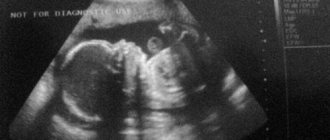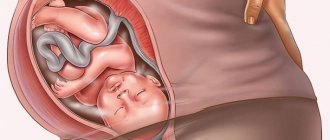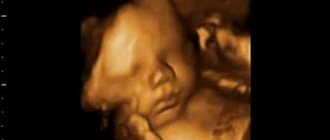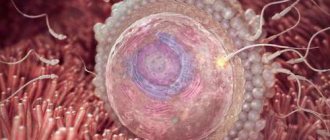Home / Health / Pregnancy
Back
Published: 01/15/2020
Reading time: 5 min
0
1681
5 / 5 ( 1 voice )
The 5th week of pregnancy, also known as the 3rd week after conception, is the beginning of the second month of pregnancy - this is the time when we most often learn about the baby. A pregnancy test purchased at a pharmacy confirms suspicions. Congratulations. You are just beginning a long journey full of changes in your life. For many expectant mothers this is fantastic news and dreams come true, for others it is a real surprise. What awaits you in the 5th week of pregnancy?
Your baby is only 3 weeks from conception at the 5th obstetric week of pregnancy. It is not very large yet - the diameter of the embryo is only 1 to 3 mm during this period. However, it is already beginning to develop intensively.
What can you see on an ultrasound during the test? The fifth week of pregnancy is the point at which ultrasound can determine the presence of a gestational sac in the uterus.
Ultrasound imaging results early in pregnancy depend largely on when the test is performed. During this period, only the gestational (fetal) sac is visible on ultrasound.
At the fifth or sixth week, a yolk sac and two to three millimeters of an embryo appear inside. At the end of the fifth week, he already has a spherical headband, but it still resembles clear jelly.
- What happens to the fetus
- Fifth week of pregnancy: symptoms and feelings of the expectant mother
- What does the belly look like in the fifth week of pregnancy?
- 5th week of pregnancy: the most important recommendations
- Video: what happens to mother and baby at 5 weeks of pregnancy
Fetal development at 5 weeks of pregnancy
This week marks the beginning of the embryonic period of the child’s intrauterine development. Together with it, the first critical period of pregnancy comes into force, the formation of the internal organs of the unborn baby begins: intestines, urinary tract, kidneys, liver. The fetal cardiovascular system and brain develop and improve. By the 35th day of intrauterine life, the nasal processes, oral cavity and upper lip are formed. At this time, the fetus is especially vulnerable to the effects of unfavorable factors - infections, toxins and hormonal disorders of the mother's body.
| Development parameters | Approximate indicators of the norm (at this time) |
| Fruit size | ~ 3 – 6 mm |
| Fetal weight | less than 1 gram |
What important things happen in the fetus?
- the neural tube transforms into the spinal cord and spinal tissue;
- the heart becomes four-chambered, valves begin to form;
- the most important process of placenta formation begins;
- the rudiments of the tongue, parts of the lungs, and pancreas appear;
- the esophagus separates from the trachea and becomes clearly visible;
- the size of the auditory vesicles increases;
- lens development continues;
- the olfactory (nasal) pits are formed;
- gonads are formed.
How does the fetus develop?
In the first month of pregnancy, the length of the embryo is on average 5.5 mm. At the age of 32-33 days, the upper limbs lengthen, the formation of hands and innervation of the arms is planned. The embryo develops a notochord (future spine) and a neural plate, from which its entire nervous system will be formed.
A baby at 5 weeks looks more like a tadpole than a person. It is curled into an arc, the neck curve is visible, the head almost touches the tip of the long “tail”. Blood flows in its vessels, which exchanges blood with the developing placenta through the umbilical cord rudiment. The membranes of the embryo begin to produce amniotic fluid, in which the baby will live in the mother's womb until birth.
On a note! If a woman wants to make sure that the pregnancy is uterine and is developing according to the term, then, in consultation with the doctor, she can undergo an ultrasound examination.
Normally, an ultrasound will determine the place of attachment of the fertilized egg in the uterus and answer the question of whether an embryo is present in it.
What happens to the embryo: development and growth characteristics
At the beginning of the 5th week, the embryo begins active growth and gradually gains mass, this leaves its mark on the condition of the mother’s internal organs.
The outer and inner shells change, the simultaneous development of all systems and organs, the rudiments of muscles and nerves, the respiratory and cardiovascular systems begins. During this period, placental tissue, umbilical cord and future cartilage tissue appear.
What does an embryo look like at 5 weeks?
At week 5, the embryo is still very small, cylindrical in shape, weighs only about 1 gram, dimensions vary by approximately 1.5-2.0 mm. It can be compared to a poppy seed. The embryo, together with the membranes, occupies approximately 25% of the uterine volume. With a good magnification, the rudiments of the spinal column, limbs, head are visible, small growths are visible on the arms and legs - future fingers.
What organs and systems are developing?
By the end of the fifth week, the fetus may increase to 2.5 mm. Intensive formation and formation of many internal organs will give an increase in mass and volume. During this period, the central axis of symmetry of the body of the future person is formed, the head part is separated from the body, and the abdominal and dorsal regions of the body are formed.
What is being formed?
The most important change in the fifth week is the formation and closure of the neural tube of the embryo with the participation of folic acid.
From this tube the brain and spinal cord are subsequently formed. Other systems are just beginning to emerge:
- then a system of blood vessels is formed and a heart appears, which is already embedded in the future thoracic part, its size is very small, but by the end of the week it may make its first contractions;
- the respiratory organs are in the initial rudimentary state - the respiratory tube and larynx;
- on the already selected head part, recesses are formed for the ears, mouth and eye sockets;
- a yolk sac appears, producing future germ cells;
- The formation of the notochord occurs, from which the spinal column will subsequently grow.
In addition, in the fifth week, somites appear, the initial cells for the formation of future muscle tissue, bones and cartilage.
What has already been formed?
An important acquisition of the fifth week is the gradual improvement of the primary vessels, which already permeate the body of the embryo and deliver nutrients and oxygen.
The body of the embryo itself is already composed of three different layers:
- outer layer or ectoderm, spinal column, ears, skin and hair, tooth enamel and eyeballs.
- the middle layer or mesoderm, vessels, arteries, heart, bone, muscle and cartilage tissue are formed;
- the inner layer or endoderm, the formation of organs of the respiratory system, gastrointestinal tract, thyroid gland and liver tissue occurs.
Changes in the body of the expectant mother at 5 weeks
A small life grows inside a woman, and changes in her body occur every day, although the pregnancy is still invisible to the mother herself and those around her. The uterus, which before pregnancy was smaller than a tangerine, begins to enlarge; by six weeks it will be the size of a large chicken egg. The chest becomes painful and very sensitive.
| Parameters of a pregnant woman | Indicators for this period |
| Weight gain (from the beginning of pregnancy) | ~ 0.5 – 1 kg |
| HCG level in blood | ~ 2500 – 151,000 mIU/ml |
| Norm of progesterone in the first trimester | 9-47 ng/ml – 28.5-150 nmol/l |
What does the belly look like?
There is no need to wait for external manifestations of the fact that life has arisen inside. A photo of the belly at 5 weeks of pregnancy is no different from what it was a month ago in a “pre-pregnant” state. The small uterus has not yet risen, so it is still completely impossible to recognize an interesting position by a woman’s appearance, even if this is a repeat pregnancy. But an increase or decrease in weight of ±1 kg is quite possible.
How does a woman feel during this period of bearing a child?
At the 5th obstetric week, a woman’s sensations can manifest themselves very clearly, in the form of increased emotional sensitivity, moodiness, and irritability. In many cases, the expectant mother does not feel any changes in her condition at all, until the moment her tummy begins to grow. Everything is purely individual, but still some typical emotional sensations can be identified. These include:
- acute reaction to the most harmless everyday situations, tearfulness for no reason;
- emotions “over the edge”, arising completely unpredictably - anything can cause both an attack of joy and tears;
- mood is unstable, changes many times during the day.
What may worry the expectant mother in the middle of the first trimester?
Signs and sensations of a physical nature confirm that a woman is carrying a small growing man under her heart. The most common ones include:
- constant uncontrollable drowsiness;
- inability to concentrate at the right time;
- the appearance of atypical fatigue that sets in even after waking up in the morning;
- soreness in the chest, familiar underwear becomes uncomfortable;
- The first signs of toxicosis make themselves felt: the nose becomes sensitive to foreign odors, previously favorite dishes cause nausea, appetite disappears, in transport it becomes unbearably sick, etc.
On a note! It is not uncommon at this time to experience such phenomena as “pregnant runny nose” without signs of a cold and increased salivation. The mucous membranes undergo changes, which is why the symptoms described above occur. If the rest of your health is fine and does not cause concern, then there is no need to deal with increased secretion in any special way: it will go away on its own by the end of the trimester.
If the conception was planned, then the listed signs will only be proof that everything worked out and there is a pregnancy. Otherwise, a woman may not be aware of her situation, and attribute symptoms and malaise to other circumstances. This often happens with an irregular menstrual cycle.
5th week of pregnancy – mom’s diary (video):
Pregnant woman's menu at 5 weeks
The health of a child is established literally from the first weeks of intrauterine life, so a woman needs to take care of adequate nutrition. From week 5, it’s time to start leading a healthy lifestyle and acquire healthy eating habits. For example, include a variety of cereals in your diet, supplementing them with dried fruits, nuts and berries. Vegetables and fruits should prevail in everyday food, at least 1/3 of the total daily food. For sweets, marshmallows, marshmallows and natural marmalade are preferred.
Do you need to restrain yourself from whims in food?
During the first trimester, food preferences often change, and a woman may well be drawn to salty foods. You shouldn’t limit yourself in your desire to eat something specific - now a pregnant woman can afford to eat almost everything she wants, but only without forgetting about a sense of proportion. To keep your intestines working like clockwork, eat foods high in plant fiber (whole grain bread, legumes, cereals) every day.
| Eating | Food and drink options |
| First breakfast | Muesli with milk; sandwich with cheese and butter; tea |
| Lunch | Light curd dessert; juice or compote |
| Dinner | A fresh vegetable salad; chicken noodle soup; a piece of bread; vitamin drink or compote |
| Afternoon snack | Unsweetened cracker; banana; fermented milk drink |
| Dinner | Oven-baked sea fish; stew with potatoes, eggplants and tomatoes; a piece of bread; weak tea |
| Before bedtime | Natural cottage cheese with 1 tbsp. sour cream or other fermented milk product (kefir, yogurt) |
Calcium is your best friend while pregnant, so enrich your menu with dairy and fermented milk products. Low-fat cheese, cottage cheese, “live” yoghurts and drinks (kefir, acidophilus, etc.) are especially useful. Also, at the beginning of pregnancy, folic acid and iodine are very important to prevent the development of defects in the fetus, so take care when choosing multivitamins.
Nutrition
What can you eat at 5 weeks pregnant? Basically, everything the soul desires. However, we would make the following recommendations:
- Listen to your body. He knows exactly what he is missing.
- If you have toxicosis, give up meat and eggs, replacing them with nuts, legumes and soy products.
- Vegetables and fruits are a source of vitamins and minerals. Increase your consumption of carrots, mangoes, apricots.
- Be sure to consume dairy products. Don't like milk? Eat yoghurts or cheeses!
- Avoid alcohol altogether. The fifth week is the time when all the baby’s organs are formed. Don't harm him!
Woman's lifestyle
Having learned that a new addition is coming to the family, you need to objectively evaluate your life and set priorities. First of all, it is important to take care of the health of the mother and the unborn child.
Rest
In order for the baby to develop comfortably and to receive the necessary amount of nutrients and oxygen supplied to him through the mother’s blood, it is necessary to devote sufficient time to rest and sleep. 8-10 hours of sleep per day is the minimum that an expectant mother should adhere to. If possible, you should go to bed early and try to rest more during the day. Before going to bed, it will be good to take a walk in the fresh air with your spouse.
Job
Five weeks is the time when the expectant mother does not yet have toxicosis “in full force,” but the first manifestations of pregnancy are already making themselves felt. I constantly want to sleep, there is no appetite, and everyone around seems to have conspired, not understanding what is happening to the previously energetic and full of strength woman. You should not perform “labor feats” if you are not physically able to do so - you should bring a certificate from the antenatal clinic confirming pregnancy, and the employer will provide more comfortable and easier working conditions.
Intimate relationships
At 5-6 weeks, women often begin to suffer from toxicosis and sudden changes in mood. Weakness, malaise and a general “disgust for life” - these signs can characterize this period of pregnancy. At this time, female libido, for obvious reasons, decreases. Nature itself took care of this, because the risk of losing a child in the first 12 weeks is much higher than in the next two trimesters.
According to obstetricians and gynecologists, intimacy may be present at the beginning of pregnancy, but only if the actions are careful and non-aggressive. If the expectant mother feels well, her personal life can continue in exactly the same way as before, only with a more attentive attitude from her partner.
Threats of miscarriage at 5 weeks: what you need to know
There are a number of medical problems that can complicate the course of pregnancy, and even provoke its termination at an early stage. Let's look at them in more detail in the table below.
| Causes | Description |
| Genetic | According to statistics, most miscarriages at 5-12 weeks are a direct consequence of gene and chromosomal mutations. Disorders can be associated both with a decrease in the number of chromosomes (for example, Shereshevsky-Turner syndrome) and with a pathological increase in their number (Down syndrome, etc.). Pregnancy with such a pathology freezes or is interrupted at a very short time, often even before the missed period. If pregnancy continues to develop in the presence of chromosomal abnormalities, the child is born with various malformations. |
| Endocrine | In the early stages, the normal functioning of the corpus luteum is important. This endocrine gland produces progesterone, the main hormone associated with embryonic development during pregnancy. If there is a deficiency of this hormone in a woman’s body, there is a direct threat of miscarriage. To treat this pathology, doctors use hormonal drugs containing synthetic progesterone. |
| Infectious | In the first trimester, various infections have serious consequences for the embryo, incl. and viral. ARVI, even in a mild form, can “disrupt” a pregnancy and provoke a spontaneous miscarriage. Bacterial infections during exacerbation also lead to the threat of early pregnancy loss. |
| Thrombophilic | As the pregnancy period increases, a woman's blood clotting activity also increases. This mechanism of protection against acute blood loss is provided by nature itself. But it happens that there is an excess of platelet-derived coagulation factors, which provokes the formation of small blood clots. Blood clots disrupt blood flow, causing thrombosis of the umbilical cord vessels, which leads to fetal death. |
| Immunological | Any autoimmune process during the first trimester can cause serious disorders in the embryo. In this case, the mother’s immune system begins to “attack” (produce antibodies) its own cells and tissues, perceiving them as foreign. Also, pregnancy is often terminated early if the parents of the unborn baby are identical in terms of the HLA immune compatibility system. In this case, the female body is not able to protect the life growing in the womb from immune aggression. |
| Uterine | The threat of miscarriage may arise due to an abnormal development of the uterus in a woman. These may be: duplication of the uterus, separate bodies and cervixes, arcuate uterus, etc. Defects limit the ability of the female organ to stretch, as a result of which it becomes impossible for the fetus to develop and it dies. |
What else can provoke the threat of miscarriage:
- the presence of bad habits in a pregnant woman (smoking, drinking alcohol, etc.);
- social and biological factors (work in hazardous industries, irregular daily routine, high physical activity);
- stressful situations.
Preservation of early pregnancy (video):
When to sound the alarm
Pain is the main symptom of threatened miscarriage, regardless of the obstetric week. Sensations at the time of a dangerous condition can be very different: they are determined by the severity of the woman’s condition and the individual threshold of pain sensitivity. Mild nagging pain in the lower abdomen or severe attacks even with slight uterine tone - all this indicates an emerging pathology of pregnancy.
Note! Any pathological discharge in the early stages, from brown “spotting” spots to drops of scarlet blood, is a reason for an immediate visit to a gynecologist.
What to do if you have symptoms of a threatened miscarriage
In order to make a diagnosis, you need to do an ultrasound of the uterus. The examination will show the presence or absence of hypertonicity, the condition of the embryo, the appearance of hematomas or chorionic detachment. If an ultrasound examination does not reveal a pathology, in this case the woman is examined in a gynecological chair in order to identify the root cause of the bleeding (the presence of a polyp, erosion, etc.). Such an examination will help determine whether this is indeed uterine bleeding and whether there is a danger to the development of the fetus. If there is a significant threat of miscarriage, the woman is prescribed therapeutic therapy in a hospital.
Doctor visits and examinations at 5 weeks
Having seen the two coveted lines on the test, the expectant mother often rushes to consult an obstetrician-gynecologist to confirm pregnancy. At the first visit, the doctor conducts a manual examination and makes notes on the woman’s chart about the visit. From now on, you need to come to the antenatal clinic at least once a month.
Medical supervision:
As a rule, specialists do not register pregnancy at 5 weeks, preferring to wait 10-11 weeks. This is due to the fact that at such an early stage a miscarriage cannot be ruled out, occurring due to chromosomal abnormalities in the embryo that are incompatible with life. Nevertheless, the doctor gives directions for the necessary tests and examinations, and clarifies when the woman should come with the results for registration.
Important! Increased monitoring during this period is necessary for patients under 18 years of age and over 35 years of age, as well as those who have chronic diseases or have a history of abortions, ectopic pregnancies or miscarriages.
Mandatory list of tests prescribed at this time
Among them:
- smear from the vagina and cervical canal;
- general and biochemical blood tests;
- general urine analysis;
- coagulogram;
- analysis to determine blood group and Rh factor;
- analysis for the presence of sexually transmitted diseases and hidden infections (HIV, syphilis, hepatitis).
Ultrasound at 5 weeks
Medical indications for ultrasound in the fifth week of pregnancy include:
- complaints of bleeding from the female genital tract;
- severe pain in the lower abdomen with an unclear clinical picture;
- the need to clarify the duration of pregnancy;
- use of assisted reproductive technologies;
- history of tubal surgery or ectopic pregnancy.
An ultrasound examination at 5 weeks helps determine the presence of a fertilized egg in the uterus, its size and shape. The first photo from the ultrasound will not yet be informative for the mother, but it will show the main thing - the emerging life inside her.
On a note! It is already possible to diagnose pregnancy with twins or triplets. It will be more difficult to identify twins - in this case there will most likely be one fertilized egg, and two embryos will become visible a couple or three weeks later.
Popular questions and answers:
What to do if a pregnant woman has a cold?
If you have a slight runny nose and normal temperature, it is not necessary to see a doctor. Treat yourself using folk remedies (detailed article: about treating colds during pregnancy).
If you have a high fever and severe cough, be sure to get treatment, but do not self-medicate. Contact your doctor and tell them you are pregnant. In the first trimester, the embryo is vulnerable, so be sure to treat the disease. The main organs of the fetus are formed, and a cold will lead to a disruption in the formation of organs.
How are things going with your intimate life?
In the absence of pathologies, you can have sex. Doctors, on the contrary, even recommend having an intimate life due to a lack of male hormones in the female body. Sex allows them to be produced for the embryo.
Although a woman often does not feel sexual attraction, because a “defense mechanism” is working to protect the baby.
What will an ultrasound show at 5 weeks of pregnancy?
Alas, an ultrasound examination will not yet reveal the sex of the child. An ultrasound will tell you whether the umbilical cord is attached to the uterus. The doctor will examine the fetus, ruling out developmental pathologies. It will also determine how many embryos there are, i.e. you will find out whether one child will be born or twins.
Please tell me, 5 obstetric weeks of pregnancy is how many months of a normal pregnancy?
At the 5th obstetric week of pregnancy, menstruation was delayed and you found out that you were pregnant, which means this is the 3rd week from conception.
I'm 5 weeks and 5 days pregnant and I don't feel anything. Is everything normal with pregnancy?
At 5 weeks, there may be no symptoms of pregnancy, the period is still too short, and besides, the symptoms appear individually: for some, immediately, and for others only by the 8th week.
How does the level of hCG change in the blood of a healthy pregnant woman?
The hormone human chorionic gonadotropin (abbreviated as hCG) is also called the pregnancy hormone because it is released into a woman’s blood only during pregnancy. The hormone is first produced in a woman’s body somewhere on the 11th day after conception. And then, with a successful pregnancy, its level increases every 2-3 days, and at the 5th obstetric week it is 1,500 - 5,000 mU/ml. The maximum level of hCG is observed at 8-13 weeks, and then the level gradually decreases.
I'm 5 weeks pregnant. Yesterday my lower back started hurting. Tell me why it hurts and is it dangerous for the child?
Lower back pain occurs for various reasons: adaptation of the female body to a new role - mother; old injuries, spinal problems; threat of spontaneous miscarriage. Therefore, it is important to consult a competent doctor to determine the cause of lower back pain.
Today I went to the doctor, he said that my hCG is growing slowly, what does this mean for the baby? I'm 4.5 weeks pregnant.
A slow increase in hCG levels or no increase at all is an alarming sign. Such a pregnancy can end either in a spontaneous miscarriage or in a frozen pregnancy. It is necessary to undergo an ultrasound, re-donate blood for hCG in 2 days, perhaps everything is not as sad as they say.
Top 7 tips for 5 weeks pregnant
At a period of 5 obstetric weeks, a woman in most cases finds out that she is in an interesting position. It's time to reconsider your habits and lifestyle! It is necessary to exclude coffee and alcohol from the diet, and stop smoking. Habitual activity will even require serious analysis: now the expectant mother should avoid serious emotional and physical stress.
To make your future pregnancy easier, pay attention to the following tips:
- Make sure you get enough fresh vegetables, fruits, fish and red meat into your body. If for some reason you cannot control your diet, pay attention to multivitamins for pregnant women (an obstetrician-gynecologist will help you choose the best option);
- Remember that doctors call the first 90 days of pregnancy critical for fetal development. Take care of your health, putting everything else into the background as much as possible. Don't be a hero! Now more than ever, you need more time to relax;
- any painful sensations in the lower abdomen and spotting at this stage are signs of a threat of miscarriage, miscarriage and other complications. If your stomach is very tight (as with menstrual pain), you need to act immediately - call an ambulance!;
- in the fifth week, the woman begins to be haunted by unpleasant symptoms of toxicosis - nausea, vomiting, drowsiness, lack of appetite. Cool, sour drinks - water with lemon, cranberry juice, freshly squeezed citrus juices - will help you cope with sudden lightheadedness. Carbonated drinks, including mineral water, should be avoided. You can relieve discomfort with split meals and small portions;
- The mammary glands become sensitive and painful to touch. Seamless underwear with cups without foam rubber and a cotton base will help reduce discomfort;
- aversion to familiar smells is another manifestation of early toxicosis, which can bring a lot of trouble to the expectant mother. This is a temporary problem and will go away by the end of the first trimester. In the meantime, try to avoid those aromas that provoke poor health, ventilate the room where you are more often and go out into the fresh air;
- For pet lovers, it is better to entrust the care of pets to other family members for a while. Especially if there is a cat in the house, the animal can be a carrier of a disease dangerous to the fetus called toxoplasmosis.
What to do if sensations disappear?
But if no significant changes in climatic conditions have been observed, then the following measures need to be taken:
- visit a doctor for an unscheduled examination and diagnosis;
- take special tests for hCG over time to determine whether there is an active increase in human chorionic gonadotropin;
- check the embryo for viability using ultrasound - upon the direction of a doctor.
If sensations disappear, then at this stage without an ultrasound it is impossible to determine whether this pregnancy is uterine or ectopic, in which the same symptoms and sensations are present. But if there is spasmodic pain on one side, becoming constant and quite acute, then a rupture of the fallopian tube is possible, in which women feel severe dizziness and in most cases lose consciousness. With this development of events, contacting a doctor is mandatory, especially if uterine bleeding begins.











